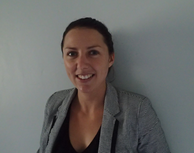 Caris Madden Caris Madden Caris Madden, the newest member of the Dunsborough Physiotherapy Centre team, recently delivered a talk to the year 6 students at Dunsborough Primary School, and Our Lady of the Cape Primary School. The talk covered a number of topics including postural awareness and scoliosis screening. All children were shown how to assess for scoliosis and received a handout (to be given to parents), showing how to assess children for scoliosis. Below is some information in regard to scoliosis which may be useful. Contact us at Dunsborough Physiotherapy Centre for more information. Phone: 97553600 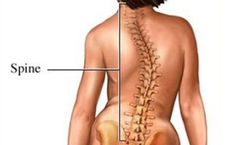 Scoliosis Scoliosis What is Scoliosis? Scoliosis is a sideways curvature of the spine that occurs most often during the growth spurt just before puberty (most common in girls aged 9-14). While scoliosis can be caused by conditions such as cerebral palsy, the cause of most scoliosis is unknown. Scoliosis is 8 times more common in girls. If you are female and your mother has suffered from scoliosis you are 20 times more likely to suffer from scoliosis. About 1 in 10 to 1 in 20 girls develop a certain degree of scoliosis in early adolescence. Adolescent idiopathic scoliosis is present in 2 to 4 percent of children between 10 and 16 years of age. It is defined as a lateral curvature of the spine greater than 10 degrees accompanied by vertebral rotation. How To Test For Scoliosis 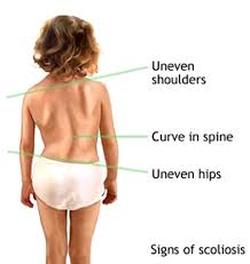 Posterior View Posterior View Posterior View Assessment Standing up straight, with feet together and arms by side, look from behind for one shoulder sitting higher than the other, one shoulder blade sticking out more, or one hip sticking out more than the other. 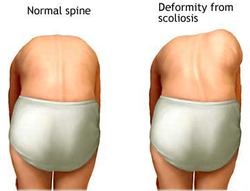 Adam's Forward Bend Test Adam's Forward Bend Test Adam’s Forward Bend Test With the person leaning forward with straight knees, hands hanging down to the floor, look for a raised rib-cage on one side. A “rib hump” is a hallmark of scoliotic curves greater than 10 degrees. Medical Assessment
If a child appears to have a scoliosis an x-ray may be ordered to assess the angle of the curve (Cobb angle). Evaluation of growth potential is assessed using the Tanner scale (sexual maturity rating) and the Risser grading system (measuring the stage of skeletal growth). Tanner stages 2 to 3 occur just after the onset of the pubertal growth spurt and correlate to the time of maximum progression of scoliosis. Risser grade is directly correlated with the risk of curve progression. Treatment There is no cure for idiopathic scoliosis. Only 10 percent of children presenting with scoliosis have curves that progress and require medical intervention. Children who have mild scoliosis are monitored closely, usually with X-rays, to see if the curve (Cobb angle) is getting worse. In many cases, no treatment is necessary. Some children (0.2%) will need to wear a brace to stop the curve from worsening. Others may need surgery (0.1%) to keep the scoliosis from worsening and to straighten severe cases of scoliosis. If untreated severe scoliosis can cause long-term back pain and breathing difficulty. Contact us at Dunsborough Physiotherapy Centre if you require further advice, or want us to assess your child for scoliosis. We are able to refer for x-rays as appropriate to assess the degree of scoliosis. Phone: 97 553600  Sports Injury Management Sports Injury Management Sports Rehab Services At Dunsborough Physiotherapy Centre we supply innovative evidence-based Sports Rehabilitation Services for those sportsmen and sportswomen who have sustained an injury during sport. Over the years at Dunsborough Physiotherapy Centre we have treated sportsmen and sportswomen of all standards, from Olympic athletes to casual social participants. Our physiotherapists have a wealth of knowledge and are able to supply effective individualised sports rehabilitation programs for injured athletes wanting to get back to what they love as soon as possible . Our physiotherapy staff are all keen sporting participants involved in a number of sports locally: soccer, tennis, surfing, running, cycling, netball, swimming, triathlons........and more. Our staff have access to, and utilise, the latest research to provide up-to-date effective rehabilitation programs. We are also well versed in the provision of post-surgical rehabilitation and follow evidence-based post-surgical rehab protocols. If you require rehabilitation following a sporting injury or post-surgery the team of highly skilled physiotherapists at Dunsborough Physiotherapy Centre can help. We also offer conditioning programs to those wishing to improve global strength, flexibility, core strength, balance, coordination, and cardiovascular fitness. 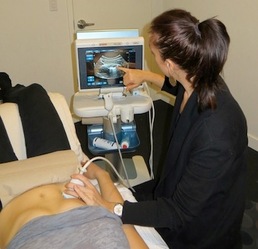 Real-Time Ultrasound Real-Time Ultrasound State of the Art Technology We have access to cutting edge technologies to aid your recovery from injury and monitor your progress accurately. Real-time ultrasound (to assess deep abdominal strength), EMG (electromyography) to assess muscle activation accurately, biofeedback devices (for assessment of appropriate muscle recruitment) laser, therapeutic ultrasound, interferential, TENS, muscle stimulation (to help stimulate the contraction of weakened musculature), dynamometry (to accurately assess muscle strength), goniometry (to assess joint ROM / flexibility), resistance devices (resistance band and resistance tubing), weights, fitballs, rollers, balance disks and wobble-boards (to challenge balance), and variable height steps are just some of the assessment and treatment tools at our disposal. We will make sure you are ready to return to the sport you love with adequate global strength, flexibility, core strength, stamina and balance (proprioception) so as to limit your risk of re-injury. We will incorporate sports-specific drills to help prepare you for your return to sport. At Dunsborough Physiotherapy Centre we provide biomechanical analysis and injury prevention strategies to limit your chance of injury during sport.  Junior Sports Rehab Junior Sports Rehab Sports Rehab for Juniors Dunsborough Physiotherapy Centre staff are heavily involved in the management and prevention of sporting injuries in junior sportspersons. We treat many younger athletes in a wide range of sporting codes. Dunsborough Physiotherapy Centre staff have treated a number of SWAS (South West Academy of Sport) juniors over the years providing conditioning programs, injury rehabilitation and injury prevention strategies. Regardless of your skill level we are able to help you with your sports rehab requirements. Ben Liston has introduced the SPRIG program (Stretch Pro-actively to Reduce Injury to Growth-plates) to junior sporting associations to help reduce injury rates in our junior sportspersons. Ben is heavily involved in junior sport, not only as a physiotherapist, but also as a local coach. For more information visit our SPRIG program page: click / tap here. 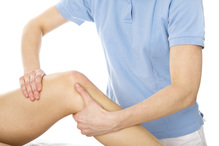 Hands-On Treatment Hands-On Treatment Hands-On Treatment and Home Exercise Program Provision Dunsborough Physiotherapy staff are able to supply effective in-room hands-on treatment as part of a comprehensive sports rehab program. We can also formulate a home exercise program specific to your condition and your stage of recovery. This program will include all the necessary exercises to improve strength, flexibility, range of joint motion, and balance (proprioception). We will progress your home exercise program in accordance with your stage of recovery. Our physiotherapists will assess your biomechanics as required, to ensure that any faults in technique are recognised and altered accordingly. We use a number of hands-on physiotherapy treatment techniques to speed recovery including joint mobilisation techniques, soft tissue mobilisation, neural stretching, muscle strengthening, rigid sports taping and kinesio taping techniques, massage, dry needling, trigger point therapy and more. We have access to numerous technologies as mentioned above which we employ as part of our sport rehabilitation therapy. 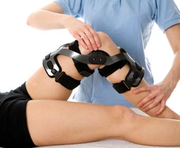 Post-Surgery Post-Surgery Post-Surgical Rehabilitation If you have required surgical intervention following a sporting injury at Dunsborough Physiotherapy Centre are able to deliver high quality rehabilitation to speed your recovery. We are aware of the most up-to-date rehab protocols, and will supply a rehab program specific to your surgery, and your surgeon's protocols. We are able to supply hands-on treatment using treatment techniques designed to relieve pain, decrease swelling, increase movement and improve muscle strength. At Dunsborough Physiotherapy Centre we also offer one-on-one hydrotherapy, pilates, massage, and physiotherapy-supervised individually designed gym programs (incorporating strengthening, stretching, joint range of movement and proprioception exercises). We are able to accurately monitor your progress with cutting-edge technology: goniometry to assess joint range of motion and flexibility, hand dynamometry and push/pull dynamometry to assess muscle strength, real-time ultrasound to assess core-strength and pelvic floor activation, and electromyography to assess muscle activity and strength. 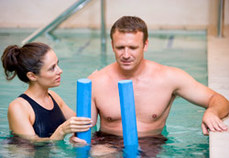 Hydrotherapy Hydrotherapy Hydrotherapy Hydrotherapy is often a useful part of sports rehabilitation, particularly in the early phases of recovery or post-surgically, Dunsborough Physiotherapy Centre offers a one-on-one hydrotherapy service. Megan Liston, a physiotherapist with over 20 years of experience will structure a hydrotherapy rehab program specific to your needs, following the relevant post-surgical physio rehabilitation guidelines. A water medium provides the advantages of buoyancy to de-load weight-bearing structures. The warmth of the water can aid mobility and reduce pain. The resistance of water can be useful to help strengthen weakened muscle groups. Turbulence of water can be used to challenge proprioception (balance). Megan is able to supervise your hydrotherapy program regularly and progress your exercises as appropriate to help speed your recover post-surgery. 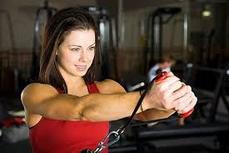 Individualised Gym Programs Individualised Gym Programs Gym Programs The physiotherapy staff at Dunsborough Physiotherapy Centre are highly skilled in the development of innovative and appropriate gym programs to aid in your recovery from injury. The physio staff can supply a gym program which is specific to your injury. Gym programs will be progressed at regular intervals to ensure a rapid return to sport. We are able to supervise your program one-on-one as often as is necessary. We will also suggest a home-based exercise program as required to target specific areas of concern. Our staff have great knowledge and background in exercise prescription and progression. We will incorporate both free weights and chain weights into your program. Importantly we will not only prescribe strengthening exercises for global muscle groups, but also ensure that adequate core strengthening is a part of your routine to lessen the risk of re-injury. 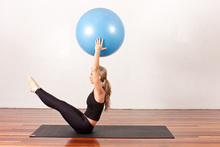 Pilates Pilates Pilates Core strengthening is an integral part of any sports rehab program. Dunsborough Physiotherapy Centre supplies one-on-one, and small group size pilates tuition. Pilates is one of the better methods of improving core strength. Evie Crowe, a physiotherapist with many years of physiotherapy experience supplies one-on-one tuition, and will progress you at an appropriate pace to ensure you engage your core effectively. A strong base of support is essential to deliver maximal global musculature power. Prescription of a home-based pilates exercise routine is also offered and is often effective in ensuring core musculature is properly engaged: often not the case if pilates exercises are progressed too rapidly. We have access to Real-Time Ultrasound to assess your deep abdominal and pelvic floor function this assessment tool will ensure you are properly engaging these core muscle groups during exercise. If you require Sports Rehab contact us at Dunsborough Physiotherapy Centre.
Phone: 97553600 Check out our Sports Rehab page for some great information about sports specific injuries, and injury prevention strategies. Website: http://www.dunsboroughphysio.com.au 15/11/2014 Sports Injury Prevention Sports Injury Management Sports Injury Management There are a number of general injury prevention strategies which apply to all activities and sports. For more specific detail in regards to injury prevention strategies specific to your sport / activity of choice contact Dunsborough Physiotherapy Centre. Our physios can provide an exercise program to limit your risk of injury. Our Sports Rehab Page has a huge amount of information about injuries commonly seen in a number of different sporting codes and specific injury prevention strategies. Injury Prevention - General Guidelines Pre-Season Conditioning Pre-Game Warm-Up / Stretching and Post-Game Cool-Down Wearing of Protective Clothing Appropriate Footwear Balance Training Core Strengthening Relevant Global Musculature strengthening Flexibilty / Joint Range of Movement program Correct Biomechanics / Technique Proper Nutrition: including hydration, carbohydrate intake and electrolyte intake. Need more information? Call us at Dunsborough Physiotherapy Centre. phone: 97553600 website: http://www.dunsboroughphysio.com.au 21/10/2014 Sports Rehab: RICER Injury Management RICER Injury Management RICER Injury Management An unfortunate part of leading an active lifestyle is suffering the occasional injury. Remember immediately following any acute injury follow the rules of RICER (rest, ice, compression, elevation and referral). Dunsborough Physiotherapy Centre physiotherapists can give you guidance in regard to the Do's and Don'ts following injury as required. 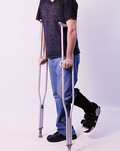 Rest Rest Rest: preferably keep weight off the injured area and limit movement / loading in the first 48 hours post-injury. At Dunsborough Physiotherapy Centre we stock elbow and axillary crutches for sale / hire. 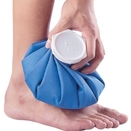 Ice Ice Ice: apply for 10-20 minutes every 3-4 hours as able over the first 48 hours: this will help to limit the effects of vasodilation following injury which leads to excessive bleeding and swelling. 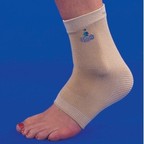 Compression Compression Compression: apply a compression bandage, support (as shown), or tubigrip (a form of compression bandage) to limit swelling. Dunsborough Physiotherapy Centre have these compressive bandages / supports available for sale.  Elevation Elevation Elevation: elevate the injured area above the level of the heart as able to minimise swelling. To lie flat is better than sitting or standing in most circumstances. 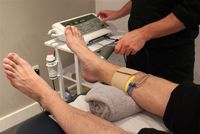 Referral Referral Referral: seek medical advice from your physiotherapist. We are able to assess the severity of your injury and treat it appropriately. If scanning is required we can refer you to radiology for x-ray / diagnostic ultrasound.
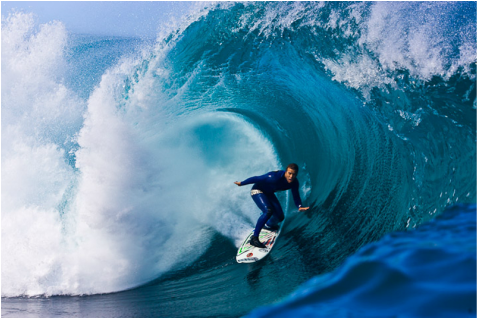 Surfing Injury Statistics Surfing Injury Statistics Common surfing injuries: The most common surfing injuries requiring treatment are lacerations, sprains, dislocations and fractures. The most common surfing injury is a laceration or cut, accounting for about half of all surfing injuries. Half of all lacerations are caused by direct contact with the sea floor. Joint sprains account for 1/4 of all surfing injuries, most commonly to the back, shoulder, knee, and ankle. Dislocations and fractures account for the remainder of injuries with the nose, teeth, and ribs the most common fracture sites. The legs (37%) and head (35%) are most common areas of injury. The torso (16%) and arms (12%) account for the rest of injuries.Acute injuries account for almost 75% of surfing injuries. Aside from lacerations, acute knee injuries are common: two-thirds of knee injuries are sprains, cartilage tears, and dislocations, mostly caused by excessive body torque when performing turns on the wave face, when landing from aerial manoeuvres, or due to a fall. Surfers are also prone to chronic overuse injuries. The most common chronic injuries are strains of the shoulder, back, and neck due to repeated paddling out into the surf. Chronic ligament sprains of the knee occur frequently due to frequent turns and twists. What causes surfing injuries? The most common cause (almost 50%) of injury in surfers is hitting a surfboard, either your own or someone else's. Wipeouts in deeper water cause about one-third of all injuries. Falling and hitting the seabed or sea litter is responsible for almost 20% of surfing injuries. Seabeds of coral double the risk of injury compared to sandy seabeds. Who gets injured? Experienced surfers tend to have more severe injuries than novices most likely because they surf larger waves in more challenging conditions. Inexperienced surfers tend to be injured more frequently, although their injuries tend to be less serious. Competitive surfers have slightly higher injury rates than recreational surfers 1 injury for every 150 hours of surfing. However, competitive surfers usually ride higher waves, perform numerous turns and twists, and often execute aerial maneuvers. Variables that increase the risk for a serious injury (requires hospitalization) versus a minor injury are age over 30 years old, advanced or expert surfing ability, and wave size over the head. There is no difference in the injury rates between men and women. How to prevent surfing injuries?
If your require rehab following a surfing injury, or wish to improve your surf fitness conditioning call Dunsborough Physiotherapy Centre phone: 97553600. For more information please visit our website: http://www.dunsboroughphysio.com.au 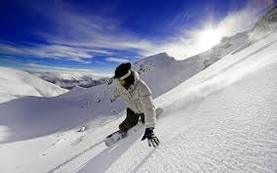 Snowboarding Injury Statistics Snowboarding Injury Statistics After recently returning from skiing in Perisher in NSW with the family I thought I would look at injury statistics and methods to prevent injury on the slopes. I have put together some basic information which will hopefully help those off snow skiing and snow boarding in Australia and overseas in the future. Snow Skiing and Snowboarding Injuries: statistics, risk factors, mechanisms of injury, and prevention. 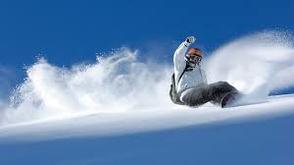 Snowboarding Injury Types Snowboarding Injury Types Injury rates in Skiers / Snowboarders Whilst on the slopes there is about a 1% chance of injury on any given day. 40% of all injuries go unreported. Snowboarders are 2-5 times more likely to suffer an injury than skiers. In both skiing and snowboarding, beginners suffer almost three times more injuries than more experienced participants. One study documents 49% of injured snowboarders were beginners versus 18% of beginner skiers. In skiers the injury rate for anterior cruciate ligament (ACL) sprains has more than tripled since the late 1970s, while the incidence of every other injury has declined (modern ski boots transmit forces to the knee and contribute to making sprained knees the most common injury in alpine skiing). The incidence of ACL sprain represents 33% of all knee injuries. Teenagers suffer the highest overall rate of injury in any one age group. Women are more likely to sustain upper extremity injuries and are twice as likely to suffer an ACL sprain. Muscle strains and tendinitis are common overuse injuries seen in skiing and snowboarding. Factors affecting Injury Factors affecting injury include the grooming of slopes, ski instruction, safety innovations in ski areas, quality of ski equipment, snow conditions, visibility, number of skiers on the slopes, skier fatigue, and the use of alcohol and other drugs. Most injuries occur between 12 noon and 4 PM. The most critical determinants of injury, however, are skier ability, relation of speed to athletic proficiency, and improper adjustment or poor functioning equipment. It has been estimated that 44% of all downhill ski injuries are due to improper maintenance and adjustment of equipment. Failure of binding release occurs in 70% of lower leg fractures and serious knee injuries. Boots: Soft boots give the snowboarder twice the risk of ankle injury compared to hard boots. "Snowboarder’s ankle," a fracture of the lateral process of the talus, is caused by forced dorsiflexion and inversion at the ankle permitted by softer boots. Hard boots place the snowboarder at risk for "boot-top" fractures of the tibia and fibula as well as double the risk for knee injury. More commonly, snowboarders fall backward as they lose their heel-edge and suffer wrist impacts, buttock contusions, axial loading spinal compressions, and occipital head injuries. Poles: "Skier’s thumb," a sprain of the ulnar collateral ligament of the first metacarpophalangeal joint is the most common injury of the upper extremity affecting skiers. Ski poles are implicated in 24% of shoulder dislocations- causing the arm to be externally rotated and forcibly abducted in a fall. Wrist guards: for snowboarders, the wrist is the most common site of injury, accounting for ¼ of all injuries and ½ of all fractures. Wrist guards have been shown to be very effective in preventing wrist injuries. Falling backward is the mechanism of injury in about 75% of wrist injuries. 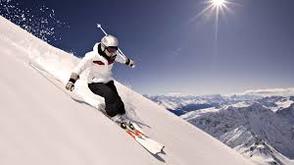 Snowskiing Injuries Snowskiing Injuries Mechanisms of Injury Falling: falling is the leading cause of skiing (87%) and snowboarding (75%) injuries. Skiers most commonly fall forward while snowboarders more often fall backwards. Jumping: Unsuccessfully landing jumps is the second most common cause of snowboarding injury. Snowboarders are injured three times more frequently jumping than are skiers. Collisions: collisions account for 10% of all injuries but 67% of hospital admissions. Most commonly collisions involve a stationary object, but often it is another person. Snowboarders have an increased rate of head injuries at 10% compared with skiers at 5%. Almost one quarter of snowboarding injuries occur during the person’s first experience. In one study wrist injuries predominated (41%) in the beginner group, shoulder injuries were most common (38%) in the intermediate group, and head injuries predominated (36%) in the expert group. Another study reported: beginning snowboarders were most likely to injure the wrists (30%); low intermediates, their knees (28%), intermediates, their ankles (17%), and advanced and experts, their shoulder or clavicle (14%).  Injury Prevention Injury Prevention Prevention Get in shape: regular general fitness and training will help reduce risk of injury. Avoid drugs and alcohol. Do not ski/snowboard if you are sick or fatigued. Equipment: be sure your equipment is properly maintained, repaired, or replaced. Wear protective eyewear, a helmet, and wrist guards if snowboarding. Dress properly in layers. Outer wear should be of a fabric to reduce sliding. Technique: snowboarders should fall with closed fists and try to roll into a fall, spreading the force of the fall out over the body instead of in one place. Those choosing to jump must know their landing site. Instruction: professional and certified instructors can significantly lessen injury rates and severity. Snow Conditions: avoid icy slopes. Do not ski alone in deep powder. Avoid crowded slopes, particularly at the end of the day. Responsibility: ski and ride within your ability. Watch for skiers downhill. Look uphill before entering a trail. Move to the side of the trail when stopping. Use devices to help prevent runaway equipment. Observe all posted signs and warnings. Have the ability to load and unload lifts. Practice courteous ski habits. "Look before you leap": use caution when jumping and leaping on the slopes, especially in snowboard and terrain parks. Keep safe on the slopes and have a great time in the snow. If you are unfortunate enough to suffer an injury whilst on the slopes call us at Dunsborough Physiotherapy Centre ph: 97553600 or visit our website for detailed information: http://www.dunsboroughphysio.com.au Dunsborough Physiotherapy Centre SPRIG program (Stretch Proactively to Reduce Injury to Growth-plates)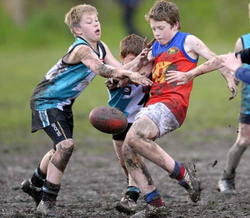 Junior sports Junior sports Dunsborough Physiotherapy Centre has recently released a program aimed at reducing growth-plate injury rates in children and adolescents in Dunsborough and surrounding areas: the SPRIG program. Three common growth plate injuries are addressed by the program: Osgood Schlatter disease, Sinding-Larsen-Johansson syndrome and Sever's disease. The program focusses on inflexibility of muscles groups related to growth-plate injuries. At present Dunsborough Physiotherapy Centre is targeting junior football, soccer, netball, and basketball players: supplying information to the associated junior sports committees, coaches and parents in relation to appropriate stretching methods to help reduce growth-plate injury incidence. At Dunsborough Physiotherapy Centre we are committed to reducing injury rates in children / adolescents in our community. Physical activity is a vital part of a well-rounded lifestyle. By reducing the rates of growth-plate injuries we are helping to keep the children / adolescents of Dunsborough and surrounding areas active, and lessening the risk of long-term issues related to these growth-plate injuries which can hamper the ability to remain active in the future. What is a Growth-Plate?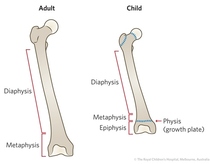 Growth-plate Growth-plate The epiphyseal plate (growth-plate) is a hyaline cartilage plate in the metaphysis, at each end of a long bone. This is where bone growth occurs until the growth plate closes (13-15 for girls, and 15-17 for boys). Growth-Plate Apophysitis / Osteochondrosis: What is it?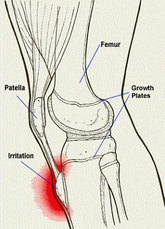 Apophysitis / Osteochondrosis Apophysitis / Osteochondrosis At the site of a tendon attaching muscle to bone tractioning (pulling) occurs which stresses the bone. The growth-plate is a weakened point of bone which is susceptible to this tractioning force: swelling and micro-fracture can develop at the site of the growth-plate, hence the painful bump often seen in those sufferers of a growth-plate injury. Growth-plate injuries often occur during growth-spurts (most common in children between 9-15 years old). During a growth-spurt bones grow at a rate faster than muscles can lengthen, leading to increased pulling at the site where the muscle attaches to bone (via a tendon). 20% or more of children will suffer from Osgood Schlatter disease. 2-14% of children presenting with a musculoskeletal injury will have Sever's disease. These conditions create pain and dysfunction (limping, weakness, pain with activity such as running, kicking and jumping, and tenderness to touch at the affected site) for 12 months or more. 3 types of growth-plate injuries addressed by SPRIG program  Osgood Schlatter Disease Osgood Schlatter Disease Osgood Schlatter disease: affecting the growth-plate of the upper shin bone (tibial tubercle) where the quadriceps tendon attaches. A bump is often seen with Osgood Schlatter disease, and pain is noted when attempting kneeling.  Sinding-Larsen Johansson Syndrome Sinding-Larsen Johansson Syndrome Sinding-Larsen-Johansson syndrome: affecting the growth plate at the lower end of the patella (knee-cap): this condition presents similarly to Osgood Schlatter disease: pain with kneeling, running and kicking. 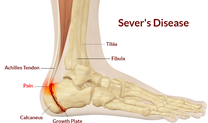 Sever's Disease Sever's Disease Sever's disease: affecting the growth-plate of the calcaneum (heel bone) where the achilles tendon attaches: painful during running-children often limit push-off when walking / running. How do I know if my child has a growth-plate injury? The Warning Signs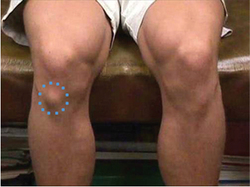 Obvious hump: Osgood-Schlatter disease Obvious hump: Osgood-Schlatter disease Tenderness to touch at the growth-plate site: top of the shin where the quads tendon inserts, lower tip of the knee-cap, or at the back section of the heel bone. There may be obvious swelling / thickening at the site. Pain with activity including running, kicking, and jumping. Loss of pace, particularly acceleration on the playing field. Pain with stretching of the quadriceps / calves. Growth-plate injuries: Risk Factors Inflexibility: during growth-spurts bones lengthen at a rate faster than muscles can accommodate and therefore inflexibility develops. This increases pulling (tractioning) at the growth-plate site. Poor footwear / poor arch support: footwear with a lack of cushioning / a lack of arch support increases the load through the growth-plates. Greater shock is absorbed through the growth-plate on landing. Over-pronation of the foot also increases load through the growth-plates. Age (growth-spurts): Osgood Schlatter disease affects boys aged 13-15, and girls aged 11-12. Sinding-Larsen-Johansson syndrome affects 10-15 year olds. Sever's disease affects 10-12 year old boys and girls aged 8-10 years old. Gender: boys are 2-3 times more likely to suffer a growth-plate injury. Prior injury: around half the children presenting with a growth-plate injury have had a prior injury to the affected area. Lack of conditioning: poor muscle tone / endurance and being overweight increases risk of growth-plate injury. Exercise: active children involved in running, jumping and kicking sports are at greater risk. Long-term implications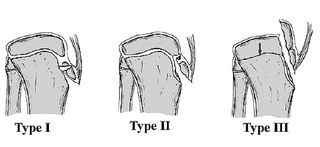 Avulsion fracture Avulsion fracture Ongoing pain: pain with kneeling / painful rubbing of the heel in closed-in footwear. Arthritic change: behind the knee-cap. Long-term loss of muscle bulk / strength. Avulsion fracture: a rare complication if not managed correctly How to Prevent Growth-Plate InjuriesThe SPRIG program focusses predominantly on stretching as an injury prevention strategy, though other prevention strategies are documented here. Stretching: stretching the quads and calves effectively and regularly to relieve the pulling force on growth-plates. 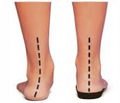 Orthotics Orthotics Good arch support / footwear: to absorb shock, and lessen pronation of the foot. This in turn lessens load through the growth-plate.  Straight leg raise Straight leg raise Conditioning: improving muscle strength with resistance work. Most growth-plate injuries occur in the first half of a sports season. As muscles fatigue increased load is transferred through the growth-plate. Contact Dunsborough Physiotherapy CentreIf you have any queries, or think that your child may have a growth-plate injury please call Dunsborough Physiotherapy Centre: phone: 97553600 To visit the Dunsborough Physiotherapy Centre website (http://www.dunsborough physio.com.au) click / tap here An unfortunate part of winter sport is injury. At Dunsborough Physiotherapy Centre we provide sports rehabilitation for those recovering from injury, or following surgery. We supply, monitor, and appropriately progress rehabilitation programs specific to your sport, and associated injury. Our physiotherapists cutting edge techniques and technologies to deliver high quality physio rehabilitation services. Our physiotherapy staff have a wealth of knowledge and will not only treat your injury effectively, but also show you how to limit risk of recurrence. To visit the Dunsborough Physiotherapy Centre website (http://www.dunsborough physio.com.au) click / tap here Injury Statistics - Winter Sports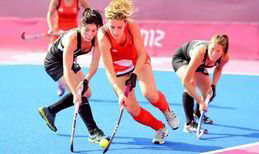 Hockey Hockey Hockey Players are not immune to injury. Those aged 10 to 19 years account for 50% of injuries, mostly in the 15-19 year age group. Overuse injuries to the ankles and lower back are common. Acute injuries commonly affect the upper limb (mostly hand and forearm), the face, and lower limb (mostly ankle, foot and knee). Common types of injury include fractures, sprains / strains and bruising. Injury rates are higher at the start of the season. The rate of injury for community level hockey players is 15 injuries per 1,000 playing hours. 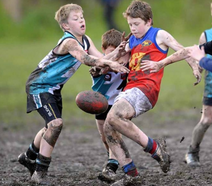 Footy Footy One of the good news stories in relation to winter sports is that recent studies have indicated that the rates of injury in junior Australian football, particularly AFL Auskick, are very low. Common causes of injuries are being tackled, hit / struck by another player, hit by the ball, and falls. Injuries are more likely to occur in the first four weeks of the playing season. Injuries to the thigh, knee, lower leg and ankle are most common. Overuse injuries occur frequently among higher level and older players. 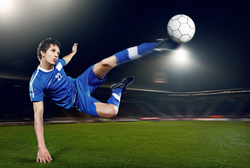 Soccer Soccer Most soccer injuries affect the lower extremities and are caused by trauma, such as a collision with an opponent or landing awkwardly from a jump, though 1/4 to 1/3 of all soccer injuries are due to overuse and develop over a period of time. The rate of injury for soccer players is up to 35 injuries per 1,000 playing hours. The older the player, the more likely they are to get injured. The most common injuries in soccer are hamstring injury, ankle sprain, meniscal (knee cartilage) injury, hernia, and ACL (anterior cruciate ligament) tear. 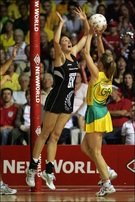 Netball Netball Netball is one of the most popular team sports in Australia. The rate of injury for netballers is 14 injuries per 1,000 hours played. Common causes of injuries are awkward landings, slips / falls, player contact / collision, overexertion, overuse, and being hit by the ball. Ankle, wrist, hand, finger and knee injuries occur frequently. The most common types of injuries are sprains, bruising, fractures and dislocations. A recent netball study found that not warming up before a game increases the risk of injury by 48%. Phone Dunsborough Physiotherapy Centre for an appointment: 97553600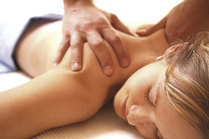 Relaxation Massage Relaxation Massage At Dunsborough Physiotherapy Centre we offer massage to suit your needs. We have an in-house massage therapist. Whether it is for relaxation, pre- or post- sporting event, or to work on tight trigger points, we are able to help. With years of experience as a trained masseur, Maritia Lightfoot is able to supply various forms of massage, including deep tissue massage, sports massage, huna massage and bowen therapy: 20 minute, 30 minute and hour long massage sessions are available. 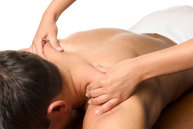 Deep Tissue Massage Deep Tissue Massage As Maritia works under the umbrella of Dunsborough Physiotherapy Centre she is able to readily communicate with any of our physiotherapists, to ascertain areas of concern which may require greater/specific attention. Call Dunsborough Physiotherapy Centre for an appointment: 97 553600. To visit the Dunsborough Physiotherapy Centre website (http://www.dunsborough physio.com.au) click / tap here
|
AuthorBen Liston of Dunsborough Physiotherapy Centre has over 25 years of physiotherapy experience. Archives
September 2016
CategoriesAll Hydrotherapy Massage Therapy Real Time Ultrasound RICER Injury Management Snow Skiing And Snowboarding Injury Prevention SPRIG Program (Injury Prevention Program For Children And Adolescents) Surfing Injury Info Winter Sports Injury Info |
Proudly powered by Weebly


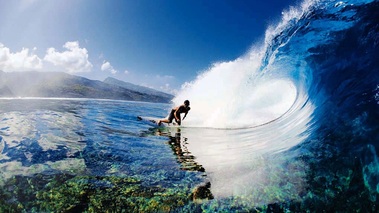
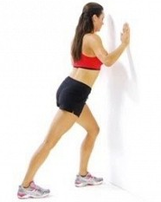

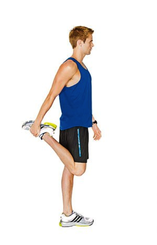
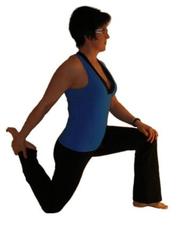
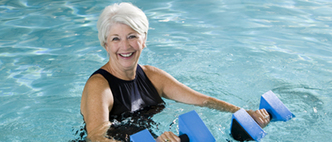
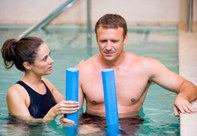
 RSS Feed
RSS Feed